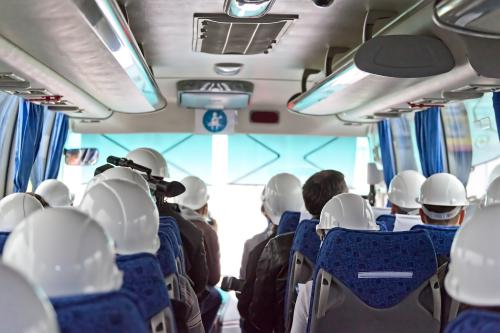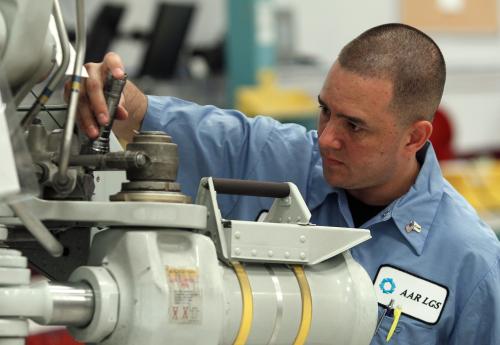Autonomous vehicles (AVs) may seem to dominate mobility conversations, but digital technologies are already here to upend our transportation experiences. Today’s cars essentially function as mobile computers, dockless scooters are appearing in more cities every day, and most of us can’t imagine traveling without GPS via our smartphones. The truth is our travel is more digital than ever before.
As that digitalization continues to gain speed, it’s going to put enormous pressure on our workforce to create, manage, and maintain all these technologies. As we recently explored, at least 9.5 million different workers—from truck drivers, to mechanics, to logisticians—are central to the country’s digital mobility workforce. A wave of new technologies and work activities are hitting every part of the country, and many of the workers involved actually have nothing to do with driving. Instead, they oversee and carry out long-term support activities, such as software design, vehicle repair, and freight management.
That’s why modernizing education and training is essential. We must equip new and existing workers with the necessary skills and knowledge to advance their careers, meet the country’s transportation needs, and connect these technologies to enduring economic growth and opportunity. This is especially important at a state and regional level where we develop many of our infrastructure and workforce development systems—and where the greatest potential for innovation exists.
We must equip new and existing workers with the necessary skills and knowledge to advance their careers, meet the country’s transportation needs, and connect these technologies to enduring economic growth and opportunity.
Consider our current workforce model in this sector. Right now, most training efforts, if they exist at all, are narrowly focused on filling high-tech positions, including engineering and software jobs that emphasize advanced programming experience and concentrate on AV testing. There are only a few nascent, region-specific initiatives that are just beginning to highlight alternative training pathways:
- Many educational institutions, such as community colleges, do not have AV-related curricula and remain fixated on IT careers. Only a few institutions like Washtenaw Community College in Michigan and Sinclair Community College in Ohio have designed coursework focused on new types of mechanical knowledge and advanced automotive technology.
- Likewise, auto manufacturers and other employers have only recently started to define a broader suite of positions focused on AV operations and customer engagement. Ford, for instance, announced a new job training partnership with the DC Infrastructure Academy, with an eye toward strengthening recruitment and training platforms for local residents.
- Labor groups and associations have also just begun to look at new collaborations, funding opportunities, and research focused on emerging AV skillsets; the Michigan Alliance for Greater Mobility Advancement and the Society of Automotive Engineers are two such groups.
- Finally, while most policymakers are caught up in debates on AV regulations, with labor impacts often an afterthought, some states like Pennsylvania are launching new comprehensive plans to better define and address digital mobility workforce needs.
In addition, the numerous and inconsistent credentials needed for these jobs represents another barrier. Occupational licenses—necessary to drive a truck or repair equipment, for instance—can vary widely from state to state, limiting the geographic mobility, pay, and career development of some workers. Likewise, certifications—including professional designations for engineers and other occupations—can require time, money, and training that some workers may not always have.
Unifying planning and action among educators, employers, and other workforce leaders at a regional level would advance a shared understanding of the most pressing workforce challenges and opportunities.
Ultimately, the lack of coordination across these different groups makes it hard to define a national digital mobility workforce strategy. However, unifying planning and action among educators, employers, and other workforce leaders at a regional level would advance a shared understanding of the most pressing workforce challenges and opportunities. And ideally, this collective mindset would help translate ideas more easily into practice, focused on common skillsets and training platforms.
Acknowledging the variety of positions, educational needs, and training requirements would mark a good start in this direction. After all, digital mobility workers fill more than 329 different occupations nationally—which do not even include emerging positions like AV fleet managers—and their educational needs can vary widely.
Engineers and software developers may be what comes to mind when one thinks of future transportation tech, but they’re the minority of all jobs. In fact, about 55 percent of all digital mobility workers—5.3 million workers out of the 9.5 million total—only have a high school diploma or less, compared to 32 percent of all workers nationally. Notably, 17 of the 25 largest digital mobility occupations fall into this category, where a majority of workers have a high school diploma or less, as evident in the large occupations listed below. Digital tech isn’t just about university graduates sitting in gleaming office spaces.

While formal educational attainment may be lower, digital mobility workers tend to develop skills and competencies on the job. Similar to other infrastructure workers involved in the skilled trades, digital mobility workers rely on higher levels of on-the-job training; more than 90 percent of these workers, for instance, typically have short- to long-term on-the-job training. From assemblers to parts salespersons to cargo agents, these workers depend on applied learning opportunities to become familiar with the tools, technologies, and other activities that are essential to perform their jobs.
And when they do receive training, workers in the largest occupations develop knowledge across many different content areas. These not only include more technical knowledge in transportation, computers, and electronics, but also softer knowledge in customer service and administration.
Add it all up and the country needs a digital workforce agenda. We need action from educators in the form of clearer curricula and programming. We need active involvement from employers and labor groups to clearly define future job requirements and provide applied learning opportunities. Policymakers need to promote portability and versatility of credentials—including any licenses and certifications—that might already be acting as a barrier to entry and career growth for some workers. There’s plenty of work to go around.
Above all, by creating a clearer roadmap for digital mobility careers, the country can concentrate on more salient issues around integrating AVs and other new technologies into the broader workplace. AV and other digital equipment manufacturers aren’t going to wait to deploy their products. We need to have the same urgency around our people.
Thank you to Romic Aevaz for research assistance on this post.








Commentary
Equipping today’s AV workforce with skills to succeed tomorrow
February 1, 2019